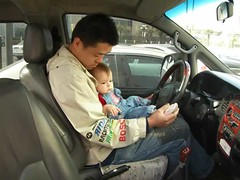Lately, I have found myself wondering about something…I even made the mistake of bringing it up to Jeff, and you know how he likes to talk about everything and anything to do with technology!
Often in our face to face classes we have the discussion around why we are using technology, to what purpose and what gain. Over and over again I hear teachers argue against the necessity of using technology because “it’s just a tool.” At first I bought into that same idea, it is just a tool that you can use to enhance learning and/or engage our learners. For years I agreed with that idea, even used that same argument myself from time to time. Recently, however, I find myself bristling when someone says “but it is just a tool!”
At some point, and I’m not sure when, technology became more than ‘just a tool.’ A tool is something that you can know how to use but maybe you don’t need to know how to use it and you can still live a full, successful life. When is the last time you heard an intelligent, successful individual convincingly argue that in this day and age, technology learning can be voluntary for students? A tool is something that helps us and makes a job easier, and yes, technology does do that (well, most of the time for most of us anyway!). So it IS a tool…but it’s not just a tool. When did that last ‘tool’ you learned to use completely change the way you thought, the way you saw your world, the way you interacted with others? Did those other ‘tools’ demand a paradigm shift in thinking? Did they inspire movements and a call to redefine what teaching and learning mean?
So no, I don’t buy that anymore, that technology is just a tool. I only have to look at my students to know for sure. Their parents can yell at them, ground them, punish them in all sorts of creative ways-but if you take away their ‘connections’, their cell phones and computers, life suddenly comes to a screeching halt. Living without their technology is unfathomable. And interestingly, I had a father tell me his daughter was grounded the other day because she left the house with out her cell phone…so much for ‘just a tool.’




 As I was reading and learning about
As I was reading and learning about So, when trying to improve my Mandarin, I did like listening to Chinesepod.com, but I also found that having a piece of paper to write the words as I heard them helped me to retain more of the language I was learning through the podcast. I now find myself wondering if Chinesepod.com were to create screencasts in lieu of/or addition to their podcasts, if this might make the learning even more versatile for all of the auditory and visual learners out there? In my brief search, the only screencasts I found them using were in their help section with tutorials on FAQ, etc. Of course, if you pay for the subscription, you have access to more materials. My question is, if screencasts are so simple and easy to make, why aren’t those offered like the free podcasts?
So, when trying to improve my Mandarin, I did like listening to Chinesepod.com, but I also found that having a piece of paper to write the words as I heard them helped me to retain more of the language I was learning through the podcast. I now find myself wondering if Chinesepod.com were to create screencasts in lieu of/or addition to their podcasts, if this might make the learning even more versatile for all of the auditory and visual learners out there? In my brief search, the only screencasts I found them using were in their help section with tutorials on FAQ, etc. Of course, if you pay for the subscription, you have access to more materials. My question is, if screencasts are so simple and easy to make, why aren’t those offered like the free podcasts? In education we constantly talk about how to engage our students, how to make learning meaningful for them. This is how we do it; we provide them with that ‘competitive voice’ that David was talking about. Understanding this new digital age comes with not just understanding the connectedness of our world, but also grasping the power that each individual has to leave her mark on that same world. Utilizing visual means, we have the ability to let our voices be heard and to sell our message.
In education we constantly talk about how to engage our students, how to make learning meaningful for them. This is how we do it; we provide them with that ‘competitive voice’ that David was talking about. Understanding this new digital age comes with not just understanding the connectedness of our world, but also grasping the power that each individual has to leave her mark on that same world. Utilizing visual means, we have the ability to let our voices be heard and to sell our message. I met with a student the other day who said to me “I didn’t finish my Powerpoint presentations because I was SO confused!” He went on to explain that in one class they are working on creating presentations in Powerpoint using more of a
I met with a student the other day who said to me “I didn’t finish my Powerpoint presentations because I was SO confused!” He went on to explain that in one class they are working on creating presentations in Powerpoint using more of a  Going back to my confused student above, the class that wanted more information on the Powerpoint was a Modern Language class-where students are not native speakers of the language they are learning/presenting in. The class that wanted a more ‘Zen’ like design was his Humanities class. This goes back to again understanding the purpose and audience for whom the presentation is intended. I feel, too, that there is a personal preference and expertise that comes into play as well. I know for me (who hates doing presentations passionately) I prefer to have a bit more information on a slide to support, inform, and (maybe a bit) distract from looking/listening to me! I also think it is about changing the way we’ve always done things. We’re moving away from the Powerpoints with listed bulleted items (gotta love the bullets, the check marks were my favorite) and moving towards a simpler, more visual presentation style. This change comes with time and an understanding why this style can be a more effective way to communicate. My guess is even people who do a lot of presenting (
Going back to my confused student above, the class that wanted more information on the Powerpoint was a Modern Language class-where students are not native speakers of the language they are learning/presenting in. The class that wanted a more ‘Zen’ like design was his Humanities class. This goes back to again understanding the purpose and audience for whom the presentation is intended. I feel, too, that there is a personal preference and expertise that comes into play as well. I know for me (who hates doing presentations passionately) I prefer to have a bit more information on a slide to support, inform, and (maybe a bit) distract from looking/listening to me! I also think it is about changing the way we’ve always done things. We’re moving away from the Powerpoints with listed bulleted items (gotta love the bullets, the check marks were my favorite) and moving towards a simpler, more visual presentation style. This change comes with time and an understanding why this style can be a more effective way to communicate. My guess is even people who do a lot of presenting (
 The idea of visual literacy is one that’s been around for quite some time. In this new era of being inundated with visual media at each and every turn, teaching skills of visual literacy suddenly become of paramount importance.
The idea of visual literacy is one that’s been around for quite some time. In this new era of being inundated with visual media at each and every turn, teaching skills of visual literacy suddenly become of paramount importance. This is an important component when looking at visual literacy. Using this explanation of visual literacy, do we teach this to our students and make sure they understand it?
This is an important component when looking at visual literacy. Using this explanation of visual literacy, do we teach this to our students and make sure they understand it? Sometimes when I stop and think about what all this means, I start to feel overwhelmed with it all. The idea of what mass collaboration means today can leave me feeling utterly exhausted with the sheer immensity of what it would, and could, look like. Then add in the idea of preparing students for a world of mass collaboration…and it’s almost more than one person can think about. I guess it’s a good thing then we have the ability to think about it collaboratively on a massive scale!
Sometimes when I stop and think about what all this means, I start to feel overwhelmed with it all. The idea of what mass collaboration means today can leave me feeling utterly exhausted with the sheer immensity of what it would, and could, look like. Then add in the idea of preparing students for a world of mass collaboration…and it’s almost more than one person can think about. I guess it’s a good thing then we have the ability to think about it collaboratively on a massive scale! My initial reaction to this was maybe it’s time for the ‘person’ of the year to be “us” instead of “you.” If we’re talking about mass collaboration, maybe we need to start thinking about the idea of we instead of me. Dana wrote something similar on her
My initial reaction to this was maybe it’s time for the ‘person’ of the year to be “us” instead of “you.” If we’re talking about mass collaboration, maybe we need to start thinking about the idea of we instead of me. Dana wrote something similar on her